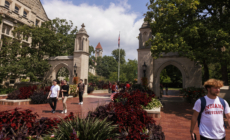-
Penn Agrees to Limit Participation of Transgender Athletes - 8 mins ago
-
Ballerina Gets New Digital Release Date – How To Watch - 15 mins ago
-
How Trump’s big budget bill would jumpstart his immigration agenda - 49 mins ago
-
Trans Swimmer Lia Thomas Stripped of Swim Titles in UPenn Trump Deal - 50 mins ago
-
Jury in Sean ‘Diddy’ Combs Trial Reaches Verdict on All Counts but Racketeering Conspiracy - 51 mins ago
-
Cardinals $15 Million Pitcher Remains St. Louis’ Top Trade Candidate - about 1 hour ago
-
Elon Musk learns that bullies aren’t your friends. Now what? - about 1 hour ago
-
Federal Judge Halts RFK Jr.’s Mass Firing Efforts at H.H.S. For Now - 2 hours ago
-
Indiana University Guts 150 Academic Programs: Here’s What Degrees Are Going Away - 2 hours ago
-
Court approves sale of 23andMe to nonprofit led by co-founder Anne Wojcicki - 2 hours ago
Southern California is Dangerously Dry for This Time of Year
Southern California is extremely dry right now, with huge portions of the region having seen less than a quarter-inch of rain in the last eight months. The landscape is parched and vegetation is withered, making the area dangerously susceptible to burning, an unusual situation for January.
“The sort of dryness we’re seeing in a lot of the plant species right now mirrors what you would typically expect in October or early November, when the rainy season starts,” said Jonathan O’Brien, a meteorologist with the U.S. Forest Service.
Wildfires are a year-round threat in California. But a good soaking of rain in fall or at the start of winter usually puts an end to the peak part of wildfire season, when the most destructive wildfires typically occur. About two inches of rain is required to saturate the ground and vegetation and significantly lower the wildfire risk. Northern California has received that much and a lot more recently, thanks to a series of powerful storms in November and December.
Southern California generally trends drier than in the north, but the region has usually received a shot or two of rain by the end of December, and certainly by early January. Not this year.
The region’s dry start to winter comes after a summer marked by prolonged, record-breaking heat that baked the landscape and cooked the trees and brush.
The National Weather Service gauge in downtown Los Angeles, a good indicator for rainfall in Southern California, has recorded only 0.29 inches of rain since May 1, 2024. This is second-least amount of rain ever measured in this roughly eight-month time period, with records going back to 1877.


















